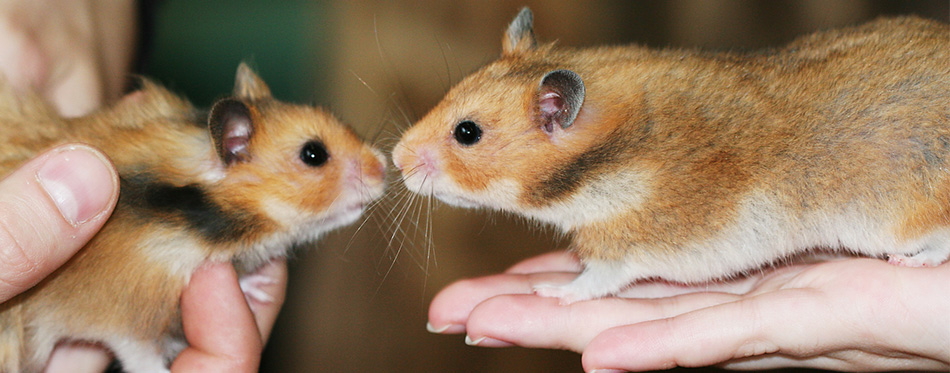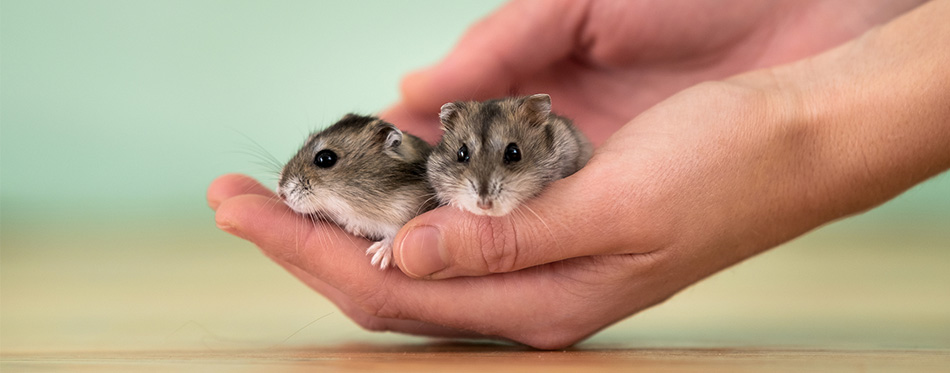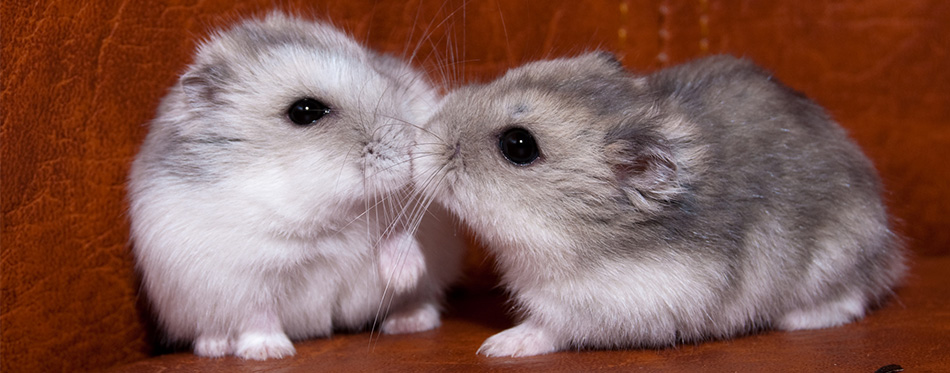Hamsters don’t bark like dogs do. They don’t meow like cats either. This does not mean that they do not know how to communicate with their fellow hammies or with their owners. They can also display a number of body language that animal lovers have learned to decipher through the years. If you’re wondering how hamsters communicate, then you will find this article very helpful.

Stretching and Yawning
You might see your little furry friend open its mouth and squint its eyes. The hammy is yawning. It is not sleepy, though. When combined with stretching, this behavior can mean that the animal is happy, relaxed, and comfortable.
Take note, however, that yawning can also be a sign of exhaustion, boredom, or nervousness. It is always best to decipher the hamster body language by understanding the context in which you observed the behavior.
Grooming
Like cats, hammies are very fastidious little creatures. Grooming is their way of cleaning their fur and washing their paws. It makes them feel good about themselves. Hamsters can only find time to groom themselves in the correct way if they feel secure about their environment. Think about it. If you know that there are predators in your surroundings, would you be able to find time to groom yourself? You would rather hide and stay alert. This is what the hamster thinks. If you see it grooming itself, then you know that it feels secure, safe, and content in its environment.
There is another side to this behavior. If you notice the hamster to be very preoccupied with cleaning itself up, then something must be wrong. It can mean that the hammie is nervous and is trying to calm itself. It is also possible that it has skin problems. In such cases, a trip to your vet is a must.
Ear Signs
Hamsters can also show their mood based on the movement of their ears. If you notice your little pet with its ears forward, it means that the hammie is alert. It is trying to gather as much information as possible from its surroundings. Remember that these pets are prey animals. As such, they are always on the lookout for signs of predators. In most cases, the hamster is insecure. This is true if you also notice the animal with its cheek pouches all puffed up.
If you notice the hamster to have its ears folded back, it can mean two things. First, the hammie is too exhausted that it prefers to rest than interact with you. It is important to understand this from the perspective of the pet. If you observe this behavior right after the hammie’s playtime, then you can say that your pet is too tired. Second, it can also be a sign of fear or agitation. Either way, it’s best to leave the hamster alone.

Sounds
Hammies do not meow like cats or bark like dogs. However, they produce vocalizations that can mean different things.
Hissing is almost always a sign of fear in a hamster. It can also suggest aggression. Nobody knows why certain non-snake animals hiss. Most believe that it is their natural way of adapting to the presence of a predator. When a hammie hisses, it mimics the sound of a serpent. Most of a hammie’s predators are also prey to snakes. Hissing is the hamster’s way of protecting itself. If you hear this sound from your pet, back away.
Teeth chattering also means that the hamster is not in the mood. It does not want any form of interaction. It is the animal’s way of saying that you should back off and stay away. Be respectful of your pet’s wishes. If you still try to hold or interact with your pet, it may nip or bite you.
Squeaking is another auditory cue that hamsters make. Unlike hissing and teeth chattering, however, this sound can mean a lot of things. It is possible that the hammie is hurt. Loud squeaks almost always signal pain or discomfort in the little animal. Squeaking can also be a sign that the hamster is frightened or threatened. If it is the latter, then you will have to look for other cues that suggests aggression. In some cases, hamsters squeak because they only need your attention.
If the small pet makes a clicking sound, it often means that the hamster is happy. It can also mean that it is content. The trick here is to always look at the circumstances surrounding the behavior that you observed. There is another theory as to why hamsters produce clicking sound. It can be a way for them to navigate their surroundings. You see, hamsters do not have good eyesight. As such, they rely on echolocation to help them find their way around.
There is also such a thing as ‘mating calls’ among hamsters. The sound that they produce is a cross between clicking and chattering. Female hamsters will “call” out to available males when they are in ‘heat’. You will also hear this sound in the winter when the nights are longer than the days. Sometimes, a nursing hamster will also elicit the sound. Males also make such sounds. They do so only when the male hamster has found a potential mate.
Fighting Another Hamster
There are species of hamsters that do not like sharing their resources with other hammies. Syrian hamsters are notorious for being loners. Hence, when they get to meet another hamster, fighting can be a real issue. If you see two hamsters squaring off against each other, there are several behaviors that you will notice.
You will notice the hamsters circle and sniff one another. What is more peculiar is that they always assume a T-formation. One hamster will be lying on either its back or its side. The other will be sniffing the belly of the one lying down. In some cases, biting the underside of the other is necessary to topple it over. They then switch positions. They do this to determine who is more dominant between them.
It is easy to determine which one is the submissive hamster. It opens its mouth and will have its paws extended. You will also see the submissive hammie to be in the upright position. It does this to threaten the other hammie.
Some hamsters will hold one of their paws out. They also try to avoid making eye contact with the aggressor. This will help appease the other hammie. The submissive hamster will often lie still. Freezing during a fight is a sign of surrender.
If this does not work, the tension can escalate into fighting. The more aggressive hammie will not let the other escape. Running is a natural part of the submissive hamster’s defensive strategy. It will try to run away from the aggressor. Unfortunately, the aggressive hamster will not often let the other get away. This leads to more biting.

Other Hamster Body Language
Creeping is a sign that something is amiss with your hamster. These pets can be very deliberate in their movement because of severe pain. When you combine this body language with a loud squealing sound, there is a good chance that your pet is in severe pain.
Running can be a sign of disorientation. This is especially true if you see it blitzing around its hamster cage. It can also alternate its runs with frequent grooming episodes. While this can mean disorientation, it can also suggest pure enthusiasm. Sometimes, it can also mean anger and frustration. Everything depends on the circumstances in which you observed the hamster’s behavior.
Another sign of potential distress in hamsters is inactivity. They may look lazy, not wanting to go to their feeding or drinking stations. It is the hammie’s way of communicating that it does not feel good. If you notice sudden inactivity in your pet, it is often wise to consult with your veterinarian.
Some hamsters also like to play dead when they do not want anyone to bother them. When in a fight, freezing is a sign of submission. It is almost always a sign of fear. They pretend to be dead, so you will not have the nerve to touch them.
Unresponsiveness to your presence is similar to inactivity. As mentioned, hamsters are not always fond of people. The natural reaction is to run away. If you see your pet standing its ground when you approach its cage, it is not because it likes you. It is possible that it is injured or is ill. Unresponsiveness almost always warrants a veterinary visit.
Biting, nibbling, or chewing are other ways your hamster can communicate with you. Biting or chewing on its cage is its way of getting your attention. If it bites your hand, there is a chance that the animal can sense something delicious in your hands. Or, it can also be because you startled it. Nibbling on your hands is the hamster’s way of telling you to put it back into its cage.
Hamsters are like any other pets. They use a combination of sounds and body language to communicate with their pet owners and fellow hamsters.

